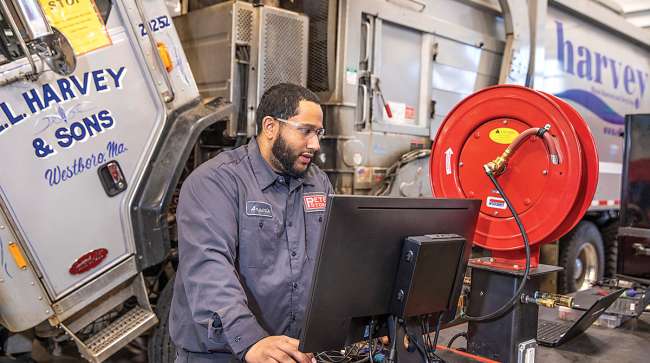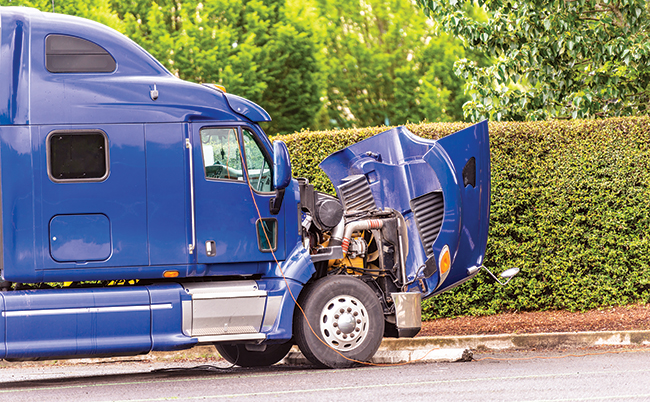Special to Transport Topics
Out-of-Network Repairs Help Dealerships Nurture New Relationships With Fleets

[Stay on top of transportation news: Get TTNews in your inbox.]
For trucking companies, securing timely repairs at their partnered truck dealerships is typically simple, straightforward and an expectation that came with the purchase. But what about when the truck is on a long haul and must be serviced by another dealer? In those likely events, truck dealers say that building rapport is the road map to a successful business partnership.
“If you just wandered into some place and you leave it totally up to the driver and the service adviser they’re dealing with, and you don’t have any meaningful conversation until you’re presented with an invoice that sent you into cardiac arrest, then, frankly, shame on you,” said Ken Calhoun, fleet optimization manager at Altec and the immediate past chairman of American Trucking Associations’ Technology & Maintenance Council.
Calhoun, who has worked for both fleets and a dealership, led a 2009 TMC effort that created recommended practice 535, a checklist fleets can use to select service providers that includes contact information, services offered, the authorization process, pricing and other information. It was designed to create open dialogue and establish expectations from both parties.
Calhoun noted that fleets typically run in established lanes unless they have a new customer or route. Fleets should initiate conversations with vendors along those lanes, learn who offers what services and work through the sticking points. The vendor’s information can be input into the fleet’s maintenance management software. Problems can be eliminated if everybody understands parameters and protocols.

Next-level technologies hold the potential to enhance safety and efficiency in transportation, but it takes a lot of work behind the scenes to advance these ideas from concept to reality. We talk with Christoph Mertz of the Robotics Institute at Carnegie Mellon and Huei Peng of the University of Michigan. Hear a snippet above, and get the full program by going to RoadSigns.TTNews.com.
Calhoun said the goal is a nonadversarial, trusting relationship with a vendor that the fleet knows is working on its behalf. He noted that throughput is important to a service provider’s business. They don’t want a customer’s asset just sitting in the shop, so it’s best for both parties for the repair to be expedited.
In order to create relationships with far-flung dealers, fleets can start with the connections they already have.
Tony Morthland, director of equipment and facilities at Nussbaum Transportation, said his company uses its home dealers as advocates. It copies its account rep on every email that goes to a dealership, including the one from which it bought the trucks.
Likewise, Jeff Harris, vice president of maintenance with USA Truck, calls his home dealer for help resolving problems with distant dealers. Those dealers often charge higher labor rates because a lower rate was negotiated with the home dealer as part of the truck purchase, he said.
Shane Barnes, vice president of maintenance for P.A.M. Transport, said his fleet relies on truck and parts makers’ national account representatives. They provide a heads-up on the service providers’ quality.
“Maintain solid relationships with your national account advisers. That’s the key,” he said.
USA Truck and P.A.M. Transport rank Nos. 67 and 68, respectively, on the Transport Topics Top 100 list of the largest for-hire carriers in North America.
Greg Arscott, president of The Pete Store, a dealership with 24 locations in the eastern United States, said fleets should start with their own dealer, who is accountable for the overall service experience and wants to sell more trucks. From there, fleets should focus on building relationships with dealers where they have the most trucks. Because of consolidation among truck dealerships, there now are fewer people to get to know.
Arscott said he avoids becoming the type of dealership that provides inferior service to fleets that don’t buy their trucks there, adding that it’s a terrible business model.
“We would be foolish for us to put a different value on a customer just because they didn’t buy a truck from us,” he said. “We’re a Peterbilt dealer, and as part of that we sign up to take care of all the Peterbilts, whether it’s a 1992 or a 2022, and whether they bought it from us or someone else.”
Arscott said his company is glad to meet fleet owners and maintenance directors in order to establish relationships.
“There’s no substitute for face-to-face contact,” he said. “If uptime is important enough to a fleet, they’ll take the time to build relationships with dealerships and service centers to make sure that they’re getting the support that they need and that location understands their business and understands their needs and their expectations.”
Fleets aren’t just customers; they’re also selling themselves. Arscott noted that just as fleets know which dealers offer good service, fleets have reputations among dealers, and should be aware of how dealerships perceive them.
“At some fleets, we never meet any of the upper management,” he said. “We always get a call from a different person in dispatch or breakdown, and there’s no rapport. … We all know in general who the easy people to work with are, and who are the ones that aren’t so easy to work with.”
More than 40% of the trucks serviced by Rush Truck Centers were not purchased at a Rush dealership, said Chad Wellborne, general manager of RushCare. With administrative tasks consuming a lot of time, having a pre-established connection enables customers to be informed about the services the dealership offers, he said. At the same time, the dealer can learn the fleet’s expectations and capabilities beforehand.
Mike Eppes, managing vice president of operations at Rush Enterprises, said proactive communications are “almost a norm” on national accounts.
“We’re trying to make sure we’re getting all that information in proactively so that when we do get that first repair to come through the door, we’re ready,” he said. “We create profiles for them, how to communicate with them, who are the decision-makers. We’re trying to capture all that so that when you go to our 120-plus locations, everybody knows how to handle that repair when it gets there, and I’d say there’s no reason that that has to be limited to a large fleet.”

When newer fleets bring their unit in for service, the dealer is able to discuss and learn the fleet's expectations and capabilities. (vitpho/Getty Images)
For smaller fleets, establishing those relationships can include a personal touch.
Jon DeBusk, director of maintenance for Arkansas-based Bowerman Trucking, a 65-truck fleet, recalled a road trip a couple of years ago when he visited customers. Along the way, he dropped in at service providers where his company had never done business. At one dealership, he asked the woman at the front desk if he could see the service manager and signed his name using a pen with his company logo. She commented about the pen, so he gave it to her and then had a good meeting with the service manager. When he called that dealership about a year later to ask about servicing a truck in the area, the receptionist answered the phone and told him she was still using that pen and would ensure he was taken care of.
Likewise, Ryan Walpole, director of purchasing and maintenance for Florida-based Walpole Inc., said the company will treat shop staff with doughnuts or pizza if they finish an unexpected repair quickly.
“I personally feel it’s a relationship industry, and if you take the time to foster and build those relationships, it will pay dividends in the long run,” he said. “Treat people with the respect and the kindness that they deserve, and it’ll definitely go a long way.”
Want more news? Listen to today's daily briefing below or go here for more info:




